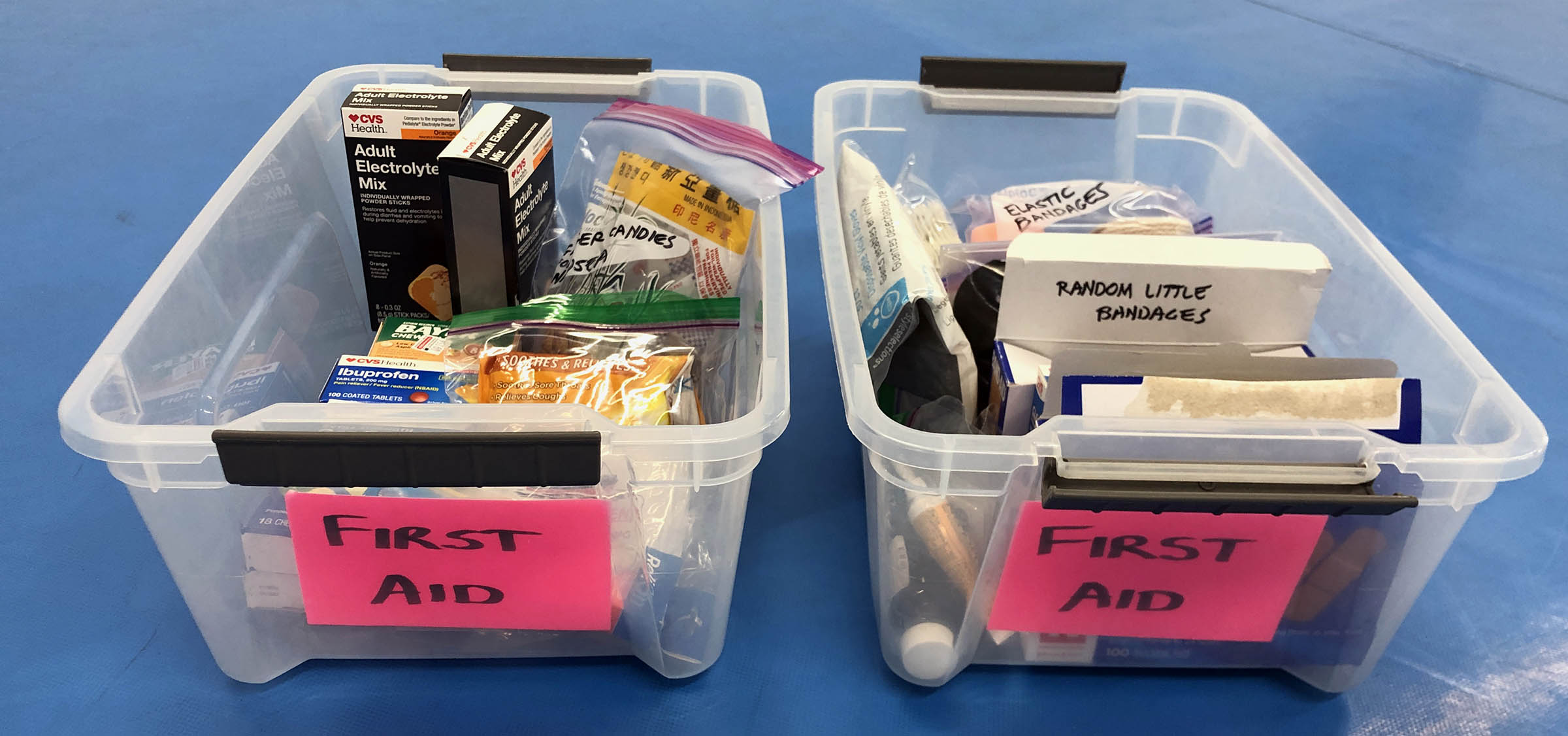I just restocked our dojo first aid kit in preparation for our annual Evolutionary Aikido seminar, and it reminded me that I’ve been wanting to share a list of items you will want to have in your dojo first aid kit.
[Note: This kit is intended for dojo member use during normal training activities. So, for instance, there’s nothing included for burn treatment. If you need a workplace first aid kit be sure to check into the legal requirements in your area or country. Here’s a good article for companies in the United States: First aid kit requirements — What OSHA and the ANSI/ISEA standard say should be in your workplace kit.*]
Fortunately, in Aikido, we don’t suffer many injuries. The whole idea of the practice, of course, is to keep ourselves and our partners safe. It is, however, a vigorous, sometimes high-intensity activity, and we inevitably suffer a few scrapes and bumps along the way.
Stocking the dojo first aid kit is something you can assign to a less-senior member of the dojo. Any responsible adult can manage this. Members are often looking for ways to contribute to the running of the school, and keeping the dojo first aid kit up to date is something they can handle while taking a little bit off Sensei’s shoulders. (Here are even more ideas for helping out at the dojo.)
What to include in your dojo first aid kit
Obviously, we need a some decent bandages, something to clean up a scrape or cut, and maybe a bottle of ibuprofen. But there are a bunch of things you may not have thought of including in your dojo first aid kit. Here’s a collection of items I always make sure we have on hand, with a few notes about each. At the end, I will include a link to download a printable checklist for when you set up, inventory, or restock your dojo first aid kit.
Equipment
- Automated external defibrillator (AED). These should be everywhere, and everyone should know how to use them. Unfortunately, they are very expensive. Most dojos cannot afford to buy one. You might want to hold a fundraiser or take up a collection. For $50-100 each you could probably have one on hand. Pro tip: Get the PulsePoint AED app. If you do not have an AED at your dojo, use the app (ahead of time) to find locations near you that do have one. These might include fire stations, gyms, large stores, medical offices, etc. Each location is shown on the map in the app. If you do have an AED at your dojo, be sure to enter it on the app so people nearby will be able to use it in case of an emergency. And tell your neighbors about it, too. A great service to the surrounding businesses.
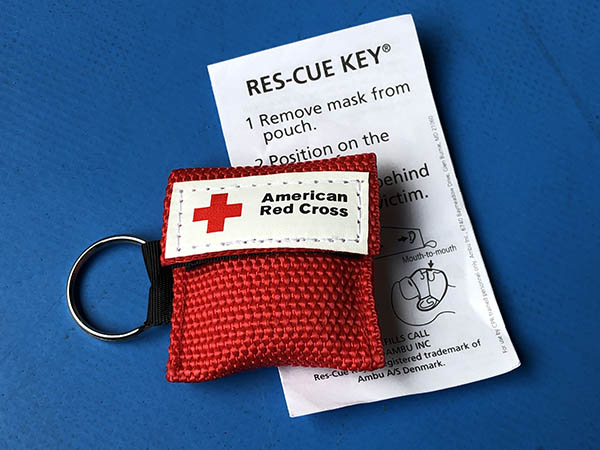
- CPR breathing barrier. This is to prevent disease transmission if you have to give CPR — cardiopulmonary resuscitation. Although you will probably never have to use it, don’t let it get buried at the back of the first aid kit. Tape it front and center, or somewhere it will be easy to grab in a frantic moment.
- Bandage scissors, or other small, non-pointy scissors. I like the “safety” scissors you find in children’s arts and craft sections. They are small, and the ends are rounded. If you have to cut a bandage off, they can usually do the job.
- Tweezers. Someone is sure to get a splinter eventually. Or come in with one that’s bothering them.
- Thermometer. Obviously, if you feel sick, you shouldn’t be at the dojo. But someone might suddenly start feeling bad and knowing their temperature could be helpful. Or, a parent will insist that their child come to class, even when the child protests that they don’t feel good. If you suspect the child has a fever, it’s good to be able to check. Of course, clean the thermometer thoroughly with an alcohol wipe between each use.
- Disposable gloves. You might as well get a decent-sized box of these. In addition for using them for medical emergencies, you can use them for cleaning the bathroom, wiping up blood from the mat, etc. They are cheap. Don’t skimp. Use them when you need them.
- Ice packs. We have six or eight of the reusable gel kind on hand, about 6″x12″, which we keep in a small freezer so they are always ready for use. These are inexpensive in the long run, and handy for bruises or sprains. An advantage of having quite a few is that if you need to send someone home with an ankle wrapped in ice packs, you still have plenty left at the dojo. They are also “therapeutic” when a child suffers some small, unfair, and upsetting bump after a difficult day at school, and just needs to feel a little cared for. If you do not have a freezer, you can purchase instant ice packs. These are typically quite small, and the inclination is to not hand them out quite so freely, as the expense builds up quickly. Whatever kind you use, always keep some fabric (their gi, or a towel) between the ice pack and the skin, so the cold does not cause a local frostbite burn.
Basic bandaging supplies
- Band-Aid flexible fabric bandages. These bandages are fantastic, and will stay on toes, even, sometimes for days. I find the box of 100, all the same size, works pretty well. If you get the assorted sizes, you would use all the large ones, and then end up with a bunch that are too small.
- Small Band-Aids also, if you run a children’s program
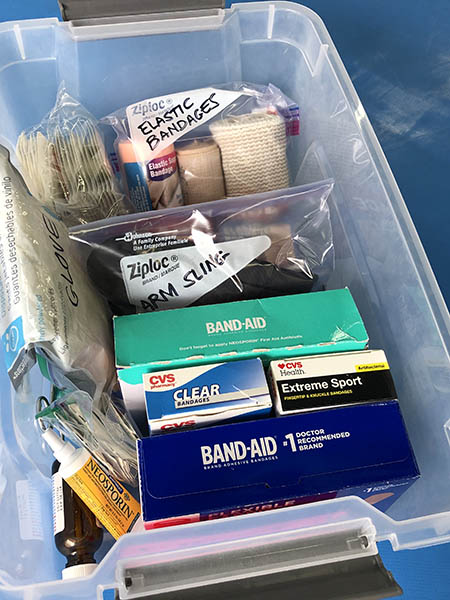
- One assortment box of latex-free bandages. There will always be someone who has a latex allergy. These never seem to work as well as the above, but you need to have them on hand as an alternative.
Note: Always ask people, especially children, if they have a latex allergy before casually handing them a regular Band-Aid. Adults should know if they have a latex allergy. Most children know, too. If you have any doubt, only offer a latex-free bandage. - A tube of your favorite antibacterial ointment. We have Neosporin on hand.
- Cohesive bandaging material. This is a light, stretchy stuff that only sticks to itself. You can use it to wrap almost anything and to hold bandages or gauze in place. It can even be used to hold an ice pack on an injury, but it’s not easy to reuse it, so you’ll just be throwing it away afterward. The sort made for people is usually 2 inches wide and light beige. In the veterinary world the good stuff is VetRap, made by 3M. The latter comes in 4 inch wide roles, and is usually less expensive than the sort for people. It’s also available in fun colors. Tip: This material gets old quickly, then won’t stick to itself well. Don’t buy too much at once, and replace it often.
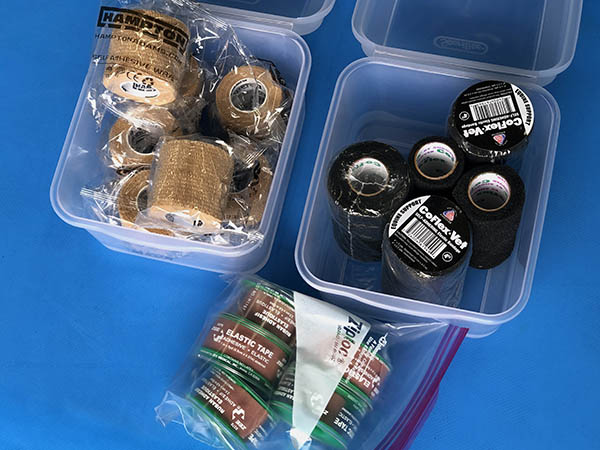
- Fabric or paper tape. Good for protecting injured toes, or for securing bandages, especially on feet, where Band-Aids can easily come off.
- Liquid Bandage, such as New Skin, can be great for sealing up small-but-painful cuts or cracks. This comes in a tiny bottle, like nail polish, and is also a good thing to include in your personal first aid kit for when you go to seminars.
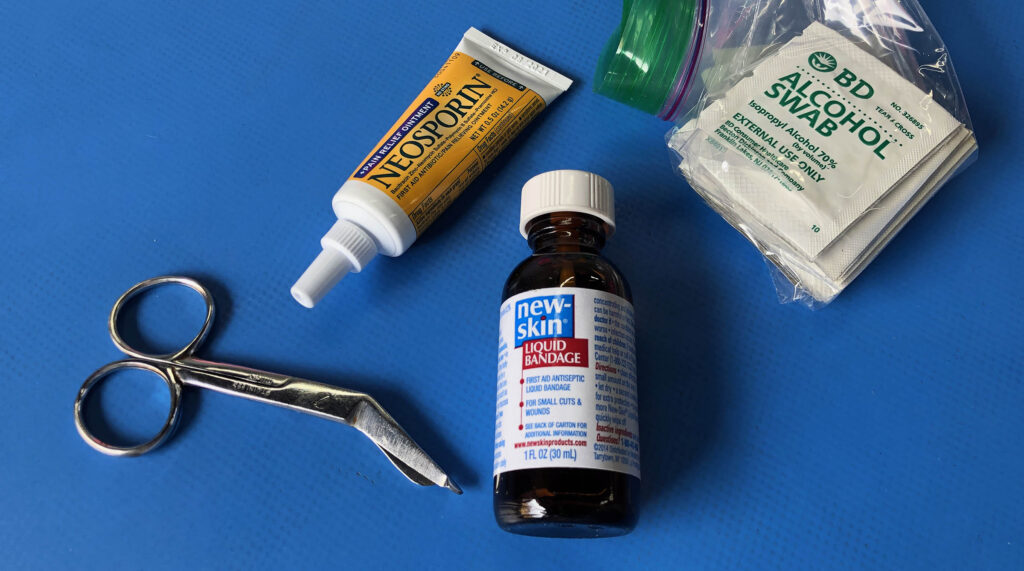
Supplies for special circumstances
- Powdered electrolyte drink mix. Gatorade powder — especially the “Frost” kind, which is higher in dextrose — or a dextrose-based electrolyte drink powder from the drugstore, can be helpful if anyone is feeling dehydrated, or possibly even suffering muscle cramps. You can find the latter in the pharmacy section, near the Pedialyte and other rehydration/ nutrition drinks. This can also be useful in case you have anyone who is diabetic and suddenly suffering from low blood sugar.
- Individual-use eyedrops. A big bottle is more economical, but nobody wants to share eyedrops. You could also keep a bottle of saline solution on hand in case someone gets something in their eye and needs a serious rinsing. Throw the bottle away after you”ve used it once. It’s cheap, and nobody wants stuff in their eye that might or might not be clean.
- A finger splint. In a pinch you can always make one out of something on hand, like a piece of cardboard and a few Band-Aids.
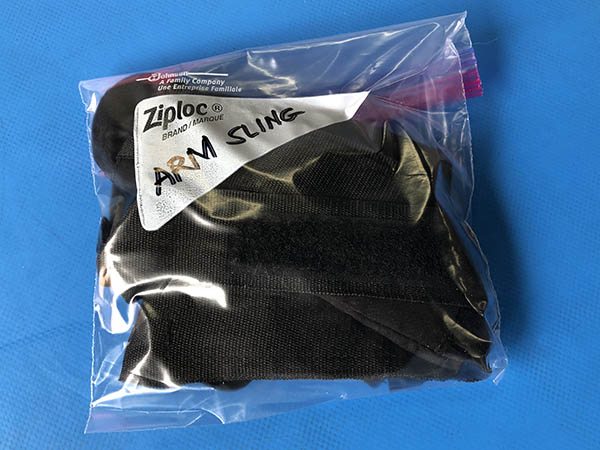
- A sling for an injured arm or collarbone. You can get a prefab sling that adjusts easily with Velcro. This is probably best, as it can be used by anyone. It’s also possible to make a sling from a triangular bandage or large square or triangular piece of fabric. I bought a cheap, lightweight scarf that’s the right size, and it takes up almost no room, in a Ziploc bag in my personal first aid kit.
- A collection of braces, supports, or wraps, such as for ankles, elbows, wrists, etc.
- Rubber crutch tips, 1 inch diameter, available from the pharmacy. This is one of my favorite dojo first aid kit tricks.They are small, inexpensive, and never expire. If someone wrenches their ankle or knee, just pop one of these on the end of their jo, and presto, they have a walking stick. This is something I always take with me, in my personal first aid kit, when I go to seminars, too.
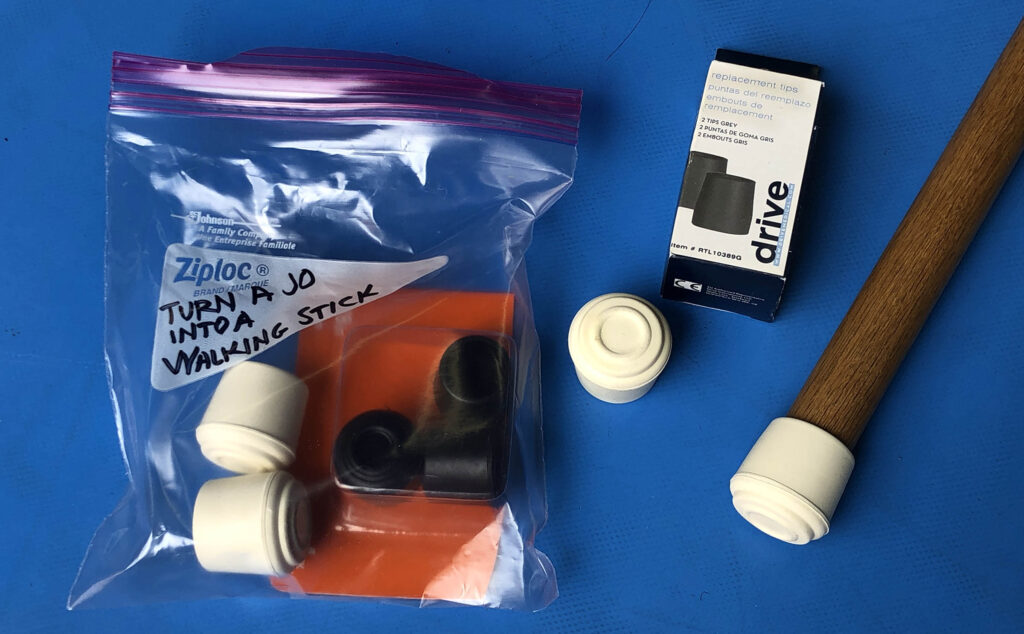
Disinfectants to keep on hand at the dojo
- Alcohol wipes. One could use these on a scrape, but they are especially important for cleaning your thermometer, bandage scissors, or anything else that might have nasty germs on it.
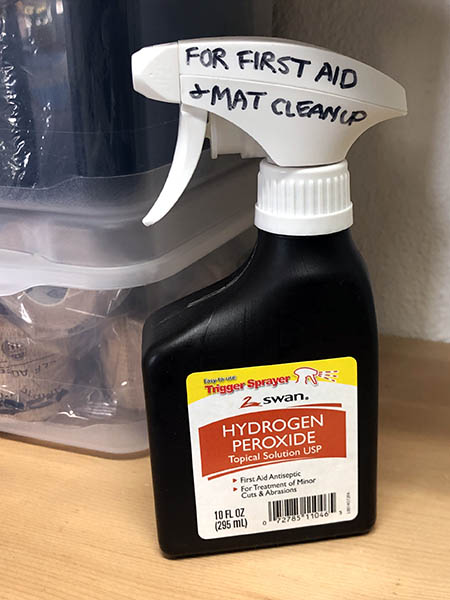
- Spray bottle of hydrogen peroxide. This is helpful for cleaning up scrapes on people, and even better for cleaning up blood on the mat, or blood on someone’s uniform. It doesn’t always get the stain out of white fabric, but it helps.
- Disinfectant wipes to use around the dojo, such as Clorox Wipes. Do not use these on people. These are the larger wipes that you can use on door handles, light switches, etc. Especially when “something is going around,” you can use them frequently to wipe down the places everyone touches.
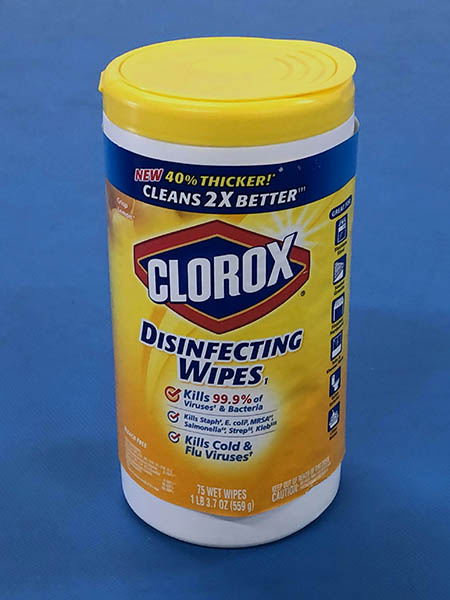
- Lysol spray, or similar disinfectant spray for surfaces. This is especially important to use if someone has been sick in the bathroom. It disinfects surfaces. It is not a room spray or air disinfectant, But lots of people seem to think it is. Read the Usage Information from Lysol and learn how to use it correctly. Most people do not. The surface needs to remain wet for at least three minutes. 10 minutes for Norovirus. I would suggest keeping it in an inconspicuous place or out of reach, as people will sometimes use it as an air freshener. You do not want to be breathing this stuff. If you want an air freshener in the bathroom, get something different and leave it where the adults (but not the children) can reach it.
Medications
It’s thoughtful to keep some common over-the-counter medications on hand at the dojo. But remember a few important points:
- Never “prescribe” any kind of medication or treatment unless you are a doctor. Don’t even casually suggest anything. You can vaguely wave in the direction of the dojo first aid kit and let people know there are some medicines available, but do not suggest “you should take an anti-inflammatory for that,” or anything of the sort. You will not understand their medical conditions and history, or know about interactions with any other medicines they take. Just don’t do it.
- Of course, never give any kind of medication to children without a parent’s or legal guardian’s permission. And do not allow children unsupervised access to the first aid kit.
- This should probably go without saying, but I’m going to say it anyway: Never keep prescription or illegal drugs at the dojo, and never offer them to anyone.
Okay, with those points in mind, here are some medications you might want to keep on hand for your members use:
- Non-steroidal anti-inflammatories (NSAIDs), such as ibuprofen (Motrin or Advil), and naproxen sodium (Aleve).
- Pain and fever medications, including aspirin and acetaminophen (Tylenol).

- Medications for stomach upset, including an antacid/heartburn medication like Tums, simethicone for gas (Gas-X), and something for nausea (Pepto-Bismol). We also keep chewable ginger candies on hand, which are great if someone is just feeling a little off kilter after doing too many back rolls or something. These candies would even be safe to offer to children, if needed.
- Gel or ointment for muscle soreness, such as BenGay, Tiger Balm, arnica, or Icy Hot. Some people prefer self-adhesive patches, like Salonpas.
- Non-steroidal anti-itch cream. The cases where we have needed this have been when a child has come in suffering from a bee sting or bite that happened earlier, and the itching is now driving them to distraction. Again, only use with their parents permission.
Naturally, people should not be coming to the dojo when they are sick. If someone has a fever or nausea, they should not be there. But maybe an instructor is feeling bad from something they ate, or someone with a sore knee would like to get started on an anti-inflammatory right away. So it’s nice to have these things on hand as a favor to your members. Again, you are never to recommend anything.
Special considerations for seminars, camps, retreats, or other dojo events
Whether you run a seminar at your own facility, or hold an event at a retreat center or other off-site location, here are some things to keep in mind with regard to your dojo first aid kit.
- If you make your dojo first aid kit portable right from the beginning, all you’ll need to do is pick it up and take it to your off-site seminar. Even if you are holding a seminar at your own facility, you might want to put the first aid kit out on the table so everyone knows where to find it easily. So instead of getting a wall-mounted first aid cabinet, use a couple of clear plastic storage bins. People will be able to see what’s in them, and they will be easy to move to where you need them.
- Remember to also pack up those things you need, but which might not be in the dojo first aid kit boxes. Many dojos use red duct tape to indicate an injury that needs gentle handling (or no handling at all). Our hydrogen peroxide spray is usually out on a shelf. We keep the eye drops in the bathroom medicine cabinet. Before you leave for an event be sure you’ve gathered up all those loose items, too.

- One thing to keep in mind is that when you have an event with people coming from other dojos, cities, or even countries, if they need ice, a wrap, etc., you will be giving away those items from your dojo first aid kit, and will need to replace them. You can prepare for this by having inexpensive items on hand, so you can send them home with a wrap on a twisted ankle, or holding ice on an injury as they drive off at the end of the seminar.
- Ice packs can be challenging at seminars. Often, at your own facility, your will have a freezer where you can keep ice packs cold. For a brief off-site event, like an afternoon weapons class in the park, you could throw your already-frozen ice packs in a small cooler and take them with you. For longer events, you can use instant ice packs that get cold on their own. These get expensive if you need to use a lot of them or use them for a long time. If there is a source of ice where you will be training, such as the ice machine at the camp dining hall or hotel hallway, you can bring large, sturdy Ziploc bags, and fill them with ice from that source. I keep big freezer type Ziploc bags in my personal first aid kit when I travel to seminars. They are small, lightweight, and easy to carry, and any 7-11 or fast food place is a convenient source of ice. Double them up so the chance of leaking is less.
Additional health and safety considerations at the dojo
A great dojo first aid kit is a necessity, but there’s more you can do to help keep your students or dojo mates safe and sound. Here are a few additional ideas:
- Be sure instructors, or at least some good percentage of dojo members, are trained in CPR/AED use, and in first aid for adults and children. You may also have medical professionals in your dojo, or others, such as fitness professionals, who are required to have this training as part of their certification process. In the United States, people can get training through the American Red Cross. It would be a great dojo project, and a service to the community, to hold a training at your dojo for your members and others. Online, or partially-online training is available, and I have done both the in-person and partially-online kinds. I highly recommend you choose the in-person trainings.
- Keep a list of emergency phone numbers handy where everyone can find it easily. In addition to 911 and other emergency services numbers, include your Sensei’s number, and the phone numbers of any other senior students who can assist if there is a problem. Also, include the non-emergency phone numbers for local law enforcement, in case members need to report anything suspicious that isn’t a crime in progress.
- Be sure everyone can find the dojo address easily, in case they need to call for paramedics or other emergency personnel.
- Collect emergency contact info for your members, especially for any children who might be dropped off for classes. Be sure all the instructors know where the contact information is kept. It’s easy for this information to become outdated. Remind members to update their contact information or other health information every few months.
- If students have any special health considerations that would be important to know in an emergency (such as diabetes, seizures, a pacemaker, etc.), ask them to include that with their emergency contact information.
One last tip: Label anything that isn’t obvious. Those crutch tips? The next person might not know why those are there. That black fabric thing? Oh! It’s a sling. It will just take you a moment, and will make things easier for other to figure out, especially when they are in a hurry, trying to find the right thing.
Ready? Get your own kit up to date!
Here’s a handy dojo first aid kit checklist for you to use when checking your inventory, replacing out-of-date items, and restocking those things you’ve used up in the past few months. I hope you find it helpful:
Click to download Your Dojo First Aid Kit Checklist (PDF)
Set yourself up to handle anything you might reasonably encounter, and then hope you never need any of it. At least you will have it, if the need arises. Safe training!

About the Author — Linda Eskin
Linda Eskin began practicing Aikido in 2009, at age 46. From the beginning she was inspired to explore how Aikido is taught and learned. In addition to mentoring adults, and now teaching a weekly Focus on Fundamentals class for students of all ranks, she assisted in the children’s programs for over eight years.
Linda loves Aikido both from the technical perspective, and as a practice of awareness and embodiment. She is completing her forthcoming book, Aikido to Zanshin – 26 Essays on the Martial Art of Peace.
Linda’s passion is encouraging people to begin, and supporting new learners of all ages.
Linda trains with Dave Goldberg Sensei at Aikido of San Diego, in California, and holds the third black belt rank, sandan.
*Thank you to Sebastian Wesen, who pointed out that different jurisdictions will have requirements for what must (and must not) be included in some first aid kits.
More Ideas on Facebook
Do you have something to add to the conversation? Your favorite must-have item for first aid at the dojo? Comment here, on the Grab My Wrist — Aikido page:
